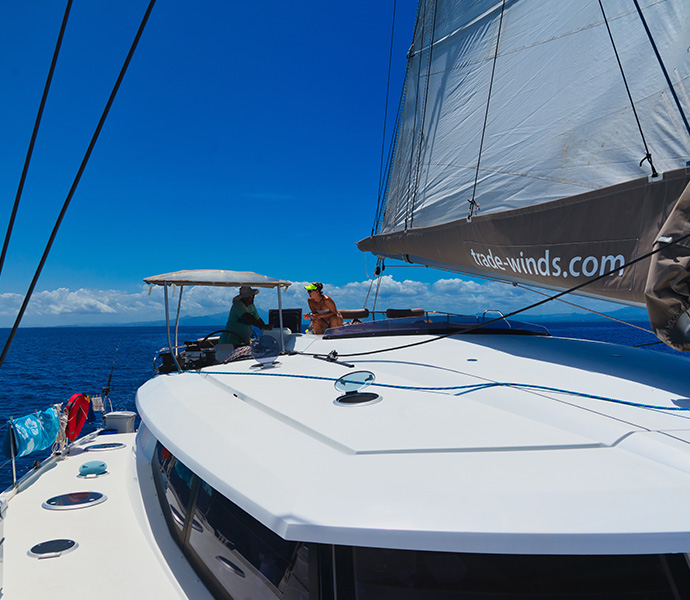An interview with Michael Krouze, chief technology officer at Charter Solutions
In sailing and in life, Michael Krouze has learned the importance of planning ahead. He’s also learned from experience that adaptability and creativity are equally – if not more – important than planning.
When Michael joined Charter Solutions in August of 2007, he served as both chief technology officer and director of the company’s new management consulting practice. His position alone was an exercise in adaptability, when after two short years the Charter team saw that, rather than a management consulting model, what clients really needed was an adoption planning model that would directly align with the tech services they were providing.
According to Michael, an adoption model is really a way of codifying a journey. The Charter Solutions team helps companies understand which technologies they should be using, how they should use them, what they need to successfully adopt new solutions, and what they can accomplish when all of this is brought together.
But, as with sailing, a successful business journey requires more than just a roadmap. An avid sailor will plan for a journey and ensure they have the right crew, the right supplies, a clear understanding of where they are going, and the ingenuity and perseverance to respond to unexpected situations.
“When you’re on the water, you learn to watch your surroundings. You watch the surface of the water, how the wind is affecting the water, as well as other boats to see what might be coming your way. Being aware of these factors allows you to quickly adapt to changes in your environment, and to assess which tools you might need,” said Michael. “All of this is critical because sometimes, you have to make do with the tools you have.”
Life at the intersection of tech and business is not much different.

One thing that sets the team at Charter Solutions apart is the care and attention they invest in not only developing the client roadmap, but creating a watertight mobilization plan that gives clients a high-level approach to what their journey should look like, the resources they will need, the milestones they should accomplish, and how to follow this journey.
For example, Charter Solutions worked with a leading data card provider on a project to move their data warehouse to Amazon Quick Sight for visualization. At the time, the organization was faced with technology that was changing around them, internal customer demands that were increasing, and a backlog of work that was 300-400 items long. The client wanted to improve the response time for requests, increase the speed of the engagement and interactions between their team and internal customers – all while breaking the cycle of dependency through which a very large group of people were dependent on a very small group of people for services. The client wanted an analytics solution that would allow them to visualize and prioritize these needs, make the small group of people enablers, and give the large group of people the skills and tools to do 80% of the work themselves. And they wanted Charter Solutions to tell them how to get there.
Charter recommended technology changes that would improve their situation – including moving to a self-service model supported by a highly agile service team. Charter also created a proof-of-concept data lake on AWS that would relieve the client of their expensive, onsite, data platform, which was causing problems. Because this was a new concept and the idea of agile data operations was new, Charter identified a low-risk data area to use for the proof of concept and built a team of internal employees and Charter Solutions experts. Together, they finished the proof of concept in 8 weeks and were able to show traceability back to the revenue stream.
Successfully adopting new technologies is not always about the latest and greatest or more expensive tech. For Michael and the team at Charter, it’s about using different technologies and finding the right technology for each client need.
“While Charter consistently stays in front of tech adoption, our work has always revolved around data and the processing of data in a heavyweight way, such as creating a platform to help a major auto manufacturer manage its fleet, leases, auctions, and more,” said Michael. “As the cloud has emerged and evolved, it has become an enabler for data and pushed tech companies to do even more with data, while helping them efficiently process and manage the analytics.”

The more things change, the more they stay the same.
While technology is always changing and advancing, the challenges for businesses still focus on growth, revenue, and survival. However, understanding how to increase the amount and quality of data and how to use that data to bring new products and services to the market is becoming a competitive advantage for organizations.
“There are three primary challenges that organizations of all sizes and categories share: The rapidly increasing amounts of data, knowing which technology to use, and being unable to change and adapt,” said Michael.
The inability to change also goes hand-in-hand with a concept known as managing technical debt. In short, this happens when organizations get so engrained, and have invested so much, into a specific tech approach that they can’t walk away from it, even if it’s the right thing to do.
“Ten years ago, you picked the tech based on your workforce. Now, you hire talent that has the skills and training to work with the technology that your customers and your marketplace are demanding,” said Michael. “The ability of an organization to shift quickly is very important. If you cannot shift quickly, you’ll find yourself paying money you shouldn’t have to pay in a manner that isn’t conducive to business.”
For example, changing the way your data is structured and housed is scary and expensive, but with new and emerging technologies, the cost to not make the change can quickly outstrip the cost of making the change. Charter’s expertise with technology and solutions like Amazon Web Services ensures clients have the guidance and tools they need to make changes quickly, efficiently, and effectively.
One thing that continues to set Charter Solutions apart from other tech companies is their ability to look beyond IT and technology to how it can be used to advance business.
“At Charter, we speak the business language and understand the need to deliver value and enable businesses to sustain. It’s not about any specific project, it’s about how we engage with our customers,” said Michael. “We have customers that come to us to talk about lofty business issues and needs, and we are always able to find the right technology to enable an effective business solution.”
Having a winning record doesn’t hurt, either. According to Michael, “It’s rare for us to come up against a problem we can’t solve. We’ve always been able to see the solution that is the most efficient and effective, and that doesn’t always mean using the most expensive or the most edgy technology.”
Run it like a startup.
Michael also credits Charter’s longevity and success to the company’s start-up mindset and culture of openness.
“When we take on a project, we run it like a startup. We follow a client’s existing protocols, but we are always looking for ways to do things more quickly, efficiently, and effectively,” said Michael. “The agile, fail-fast mentality that came out of software development and startups is core to how we identify and implement solutions.”
This mentality is nurtured by an open culture where all team members can voice their opinions without judgment or hidden agendas, which ultimately feeds productive problem solving. Couple this with a sense of fun and trust, and that fosters an environment where team members feel empowered to suggest unexpected approaches to client challenges. It’s the unique Charter culture that has contributed to the company’s success and that Michael believes will remain a cornerstone to future growth.
“There’s so much opportunity and so much for us to learn and do, and we have the team and the culture that will allow Charter Solutions to capitalize on the exciting times ahead for the tech industry and our clients,” said Michael. “This is just the beginning, and I believe we have the vision, the crew, and the resources for a fantastic journey.”



